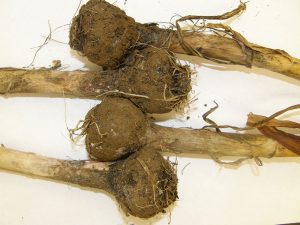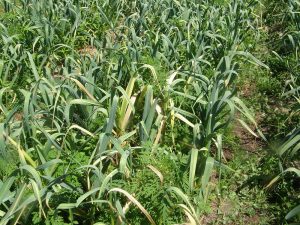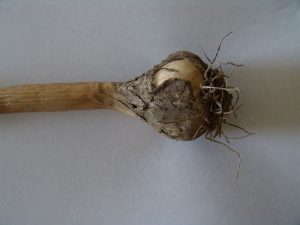Bulletin #2062, White Rot of Garlic and Onions
Bulletin #2062, White Rot of Garlic and Onions (PDF)
By Steven B. Johnson, Ph.D., Extension crops specialist, University of Maine Cooperative Extension
For information about UMaine Extension programs and resources, visit extension.umaine.edu.
Find more of our publications and books at extension.umaine.edu/publications/.

Garlic and onion white rot are caused by the fungus, Stromatina cepivorum Berk. White rot is the most important and destructive of the fungal diseases of onion and garlic. While all Allium-family plants can be infected with white rot, onion and garlic are the most susceptible.
White rot is not yet common in Maine. But the long-term consequences of this disease make it a concern for all garlic growers. Garlic and onion white rot, a previously unreported disease in Maine, appeared in several locations during the 2008 growing season. The source of the disease was traced back to garlic seed stock imported into Maine. Since 2008, additional diseased areas have appeared. Some farms have drastically reduced the amount of garlic and onion planted or abandoned garlic planting on a particular piece of land. Pathogen buildup and spread to uninfested areas is a serious concern because white rot can render a field unusable for garlic or onion production for as long as 40 years, even without an Allium host. The pathogen that causes this disease survives in the soil as sclerotia, which are dormant fungal structures. One sclerotium per 20 pounds of soil will cause disease and result in measurable crop loss; one to two sclerotia per pound of soil will result in all plants being infected.
The pathogen moves below ground at a rapid rate. Visual symptoms generally do not appear until the base of the plant is infected. Plant death soon follows. There are currently no chemical or cultural controls available to garlic growers, other than moving to fields free of the pathogen. By 2003, over 10,000 acres in California had become infested with Stromatina cepivorum. In California, failure to completely clean boxes transporting bulbs to be planted for seed production has been blamed for white rot infestation in dozens of newly planted garlic fields. Parts of Washington State, California, and Nevada now have regulations on the white rot pathogen.
Biology
Garlic and onion white rot development is favored by cool and moist soil conditions. The soil temperature optimum for infection 60° to 65°F and infection can occur from 50° to 75°F. At soil temperatures above 78°F, the disease is inhibited. Soil moisture conditions that are favorable for garlic and onion growth are also favorable for white rot development.
The sclerotia that form on the decaying host will lay dormant until root exudates, unique to Allium spp., stimulate germination. Cool weather is needed for both sclerotia germination and mycelia growth. Optimum soil moisture for Allium root growth is also optimal for sclerotia germination. Mycelium will grow through the soil until it encounters an Allium root when it initiates the infection process. Mycelium can grow from one plant to a nearby plant. This allows the pathogen to move between plants. As the disease progresses, sclerotia are formed and eventually released into the soil.
Symptoms

White rot initially appears as areas of yellowing lower leaves or stunted plants, which eventually die. The size of the infected area is related to the level of inoculum in the soil and will continue to enlarge as the season progresses. White rot may go unnoticed in a field for a period of time as sclerotia populations are building and spreading. During weather optimal for the disease, mycelial growth can occur on the base of the stem and on the bulb. Under ideal conditions, mycelia growth can cover the entire bulb, and eventually, tiny black sclerotia will form on the mycelium. Roots will also rot, making the plant easy to pull out of the soil.
Management
White rot management centers on disease avoidance and not introducing Stromatina cepivorum into the field. Plant only clean, pathogen-free garlic cloves, onion transplants, or onion sets. The seller of the planting stock will most likely include information from a testing lab if the material has been tested free of white rot. Movement of infected planting stock is the primary introduction avenue into a previously uninfested field.

Once white rot is present in a field, little can be done other than to cease planting Allium crops in the field. The Allium crops from an infested field should not be used as seed. Infected plants should not be tilled under or composted, but rather disposed of off-farm. All equipment and tools that have been used in an infested field should be sanitized with an approved quaternary ammonia product. If you suspect the presence of white rot, contact your local Extension office for verification.
Sclerotia can be spread by plant material, water movement, soil movement, equipment movement, or human movement. Sanitation is important to prevent sclerotia from moving from an infested field to a clean field. Movement of plant material or soil from an infested field can spread the pathogen and thereby the disease. Crop rotation is of limited use in disease control owing to the long persistence of white rot sclerotia in the soil.
There are no available white rot-resistant varieties of garlic or onion. Biological approaches have been investigated, but results have been variable and they do not control the pathogen.
Reviewed by David Fuller, Extension Professional
Information in this publication is provided purely for educational purposes. No responsibility is assumed for any problems associated with the use of products or services mentioned. No endorsement of products or companies is intended, nor is criticism of unnamed products or companies implied.
© 2015, 2020
Call 800.287.0274 (in Maine), or 207.581.3188, for information on publications and program offerings from University of Maine Cooperative Extension, or visit extension.umaine.edu.
The University of Maine is an EEO/AA employer, and does not discriminate on the grounds of race, color, religion, sex, sexual orientation, transgender status, gender expression, national origin, citizenship status, age, disability, genetic information or veteran’s status in employment, education, and all other programs and activities. The following person has been designated to handle inquiries regarding non-discrimination policies: Director of Equal Opportunity, 101 North Stevens Hall, University of Maine, Orono, ME 04469-5754, 207.581.1226, TTY 711 (Maine Relay System).

